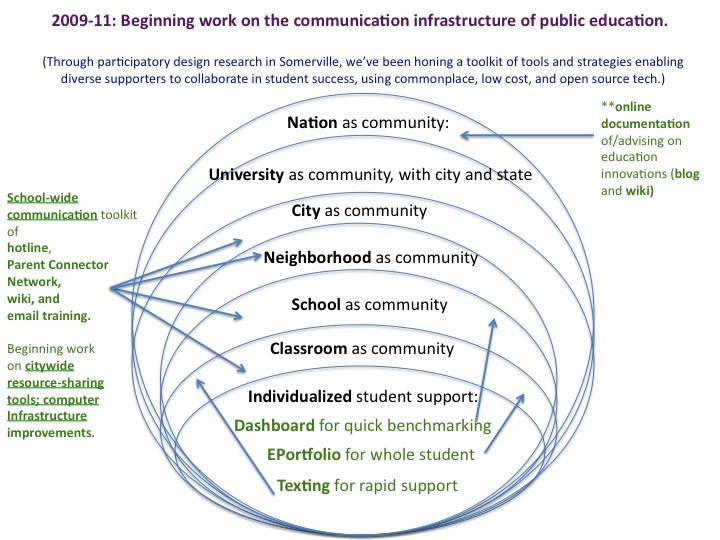About Us: Our Work: Difference between revisions
From Oneville Wiki
Micapollock (talk | contribs) |
Micapollock (talk | contribs) |
||
| Line 36: | Line 36: | ||
:d) share our efforts online, even if we're still learning -- so that others can learn from what we’ve done or teach us something new. | :d) share our efforts online, even if we're still learning -- so that others can learn from what we’ve done or teach us something new. | ||
Some of us (Mica in particular) have come to call our work [[Research base|“improving the communication infrastructure of public education.”]] That's because we're seeing that if people embed low cost communication tools and strategies in their own schools and communities, with the goal of supporting the success of every student, they can make it normal for new kinds of partnership to happen. | Some of us (Mica in particular) have come to call our work '''[[Research base|“improving the communication infrastructure of public education.”]]''' That's because we're seeing that if people embed low cost communication tools and strategies in their own schools and communities, with the goal of supporting the success of every student, they can make it normal for new kinds of partnership to happen. | ||
Improving communication infrastructure means working to ensure that on a daily basis, the people who need to communicate information and ideas so they can collaborate in young people’s success can do it. | Improving communication infrastructure means working to ensure that on a daily basis, the people who need to communicate information and ideas so they can collaborate in young people’s success can do it. | ||
Revision as of 09:47, 11 July 2012
Our way of working
The OneVille Project divided up into six smaller projects exploring tools and strategies to help people communicate. Each has paired local researchers, youth, parents, educators, technologists, and community organizers:
- Data dashboards
- Eportfolios
- Texting
- Schoolwide toolkit/parent connector network
- Citywide information sharing
- Computer infrastructure
Click here to see mini descriptions of all projects, or click the sidebar to explore any single project.
Our research questions
In various ways, we all touched upon these research questions in our six smaller projects.
- To support young people, who needs to communicate which information to whom?
- What are the barriers to that communication, and how might those be overcome?
- Which communication channels and strategies, and which efforts to build relationships, might support particular necessary communications between these people?
- When might basic tech help increase community cooperation in young people’s success, by supporting diverse students, teachers, parents, administrators, service providers, and other community members to share ideas, resources, and information and to build relationships? What are the limitations to technology use?
(You’ll see ¡Aha! written in red throughout this website. That means a moment when we figured out something of use about improving communications in education.)
Click here to learn more about other research supporting our work.
Our way of working
We've been doing participatory design research, where people work together to improve something and document/analyze that work as they do it. Click here to learn more about the principles guiding this work.
Our model has become to work with diverse community members of all ages to
- a) consider existing communication needs;
- b) test existing free tech tools and low-cost communication strategies, to ensure they support necessary communications and collaboration in a diverse community;
- c) consider which new tools and strategies need to be created, and build/test/develop them together so they seed in actual diverse schools;
- d) share our efforts online, even if we're still learning -- so that others can learn from what we’ve done or teach us something new.
Some of us (Mica in particular) have come to call our work “improving the communication infrastructure of public education.” That's because we're seeing that if people embed low cost communication tools and strategies in their own schools and communities, with the goal of supporting the success of every student, they can make it normal for new kinds of partnership to happen.
Improving communication infrastructure means working to ensure that on a daily basis, the people who need to communicate information and ideas so they can collaborate in young people’s success can do it.
Our goal with this website
Finally, our goal with this website is to create and share documentation that
- helps educators, families, and young people to tackle similar issues where they live;
- helps researchers and the public to think differently about communications in diverse public school communities;
- helps connect us to others doing similar things.
Lots of documentation of innovation in education just tells you final accomplishments. In talking to people across the education field, we've heard a need for more descriptions of "how," even if part of the story is mistakes! So, we wanted to begin to share the following:
- our ¡Ahas! about our attempts to improve communication;
- our overall realizations and products;
- examples of "how to" do everything we tried, including technical documentation.
See Vision for OneVille documentation for more specifics.
Beyond the actual work done in Somerville, we hope that our deepest contribution with this website will be to get people thinking about:
- the tools and strategies needed to support the full range of necessary communications and partnership among members of a diverse educational community;
- how low cost/free tech, brought by youth, teachers, and families into the “core” of public schools, can help people communicate and collaborate in new ways to support young people;
- how people of all ages in a diverse community can work together to innovate all sorts of solutions for public education.
Click here to learn more about our next steps.
